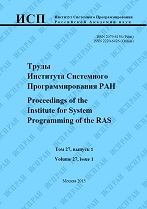|
Visual dataflow language for educational robots programming
G. A. Zimin, D. A. Mordvinov
St Petersburg State University, Institute of Mathematics and Mechanics
Abstract:
Visual domain-specific languages usually have low entry barrier. Sometimes even children can program on such languages by working with visual representations. This is widely used in educational robotics domain, where most commonly used programming environments are visual. The paper describes a novel dataflow visual programming environment for embedded robotic platforms. Obviously, complex dataflow languages are not simple for understanding. The purpose of our tool is to "bridge" between lightweight educational robotic programming tools (commonly these tools provide languages which are based on control flow model) and complex industrial tools (which provide languages based on more complex dataflow execution model). We compare programming environments mostly used by robotics community with our tool. After brief review of behavioural robotic architectures, some thoughts on expressing them in terms of our dataflow language are given. Visual language, which is described here, provides opportunity to mix dataflow and control flow models for robotics programming. We believe that it is important for educational purposes. Program on our language consists of different blocks (visual representation of data transformation processes) and "links" which presents data flow between them. Domain-specific modelling approach was used to develop our language. Also, this paper provides the examples of solving two typical robot control tasks in our language.
Keywords:
robotics, data flow, visual programming, educational robotics, domain-specific modelling, subsumption architecture.
Citation:
G. A. Zimin, D. A. Mordvinov, “Visual dataflow language for educational robots programming”, Proceedings of ISP RAS, 28:2 (2016), 45–62
Linking options:
https://www.mathnet.ru/eng/tisp19 https://www.mathnet.ru/eng/tisp/v28/i2/p45
|

| Statistics & downloads: |
| Abstract page: | 152 | | Full-text PDF : | 150 | | References: | 34 |
|




 Contact us:
Contact us: Terms of Use
Terms of Use
 Registration to the website
Registration to the website Logotypes
Logotypes








 Citation in format
Citation in format 